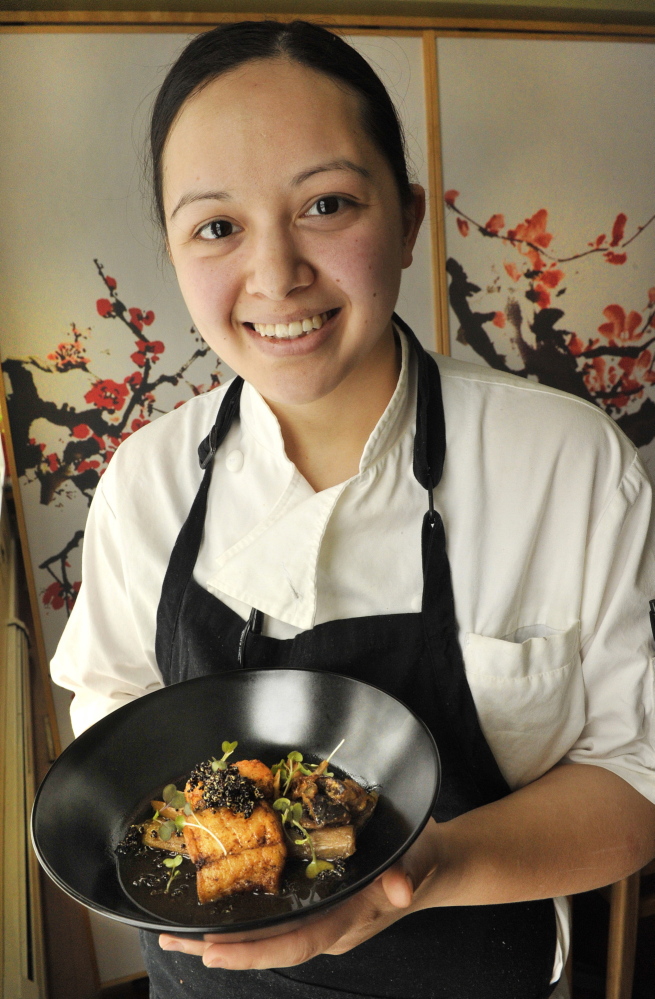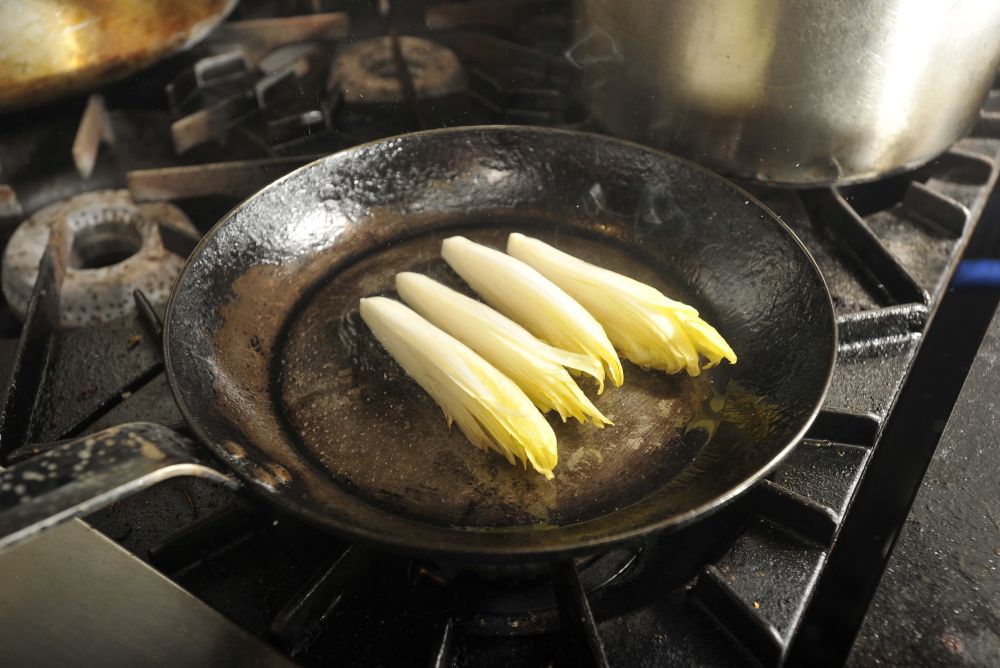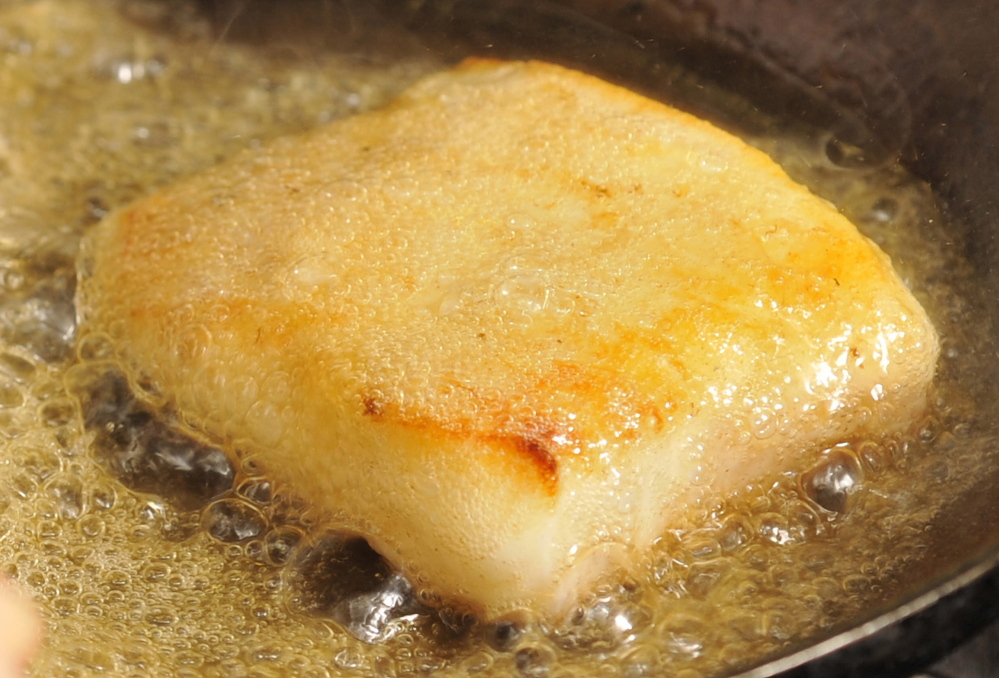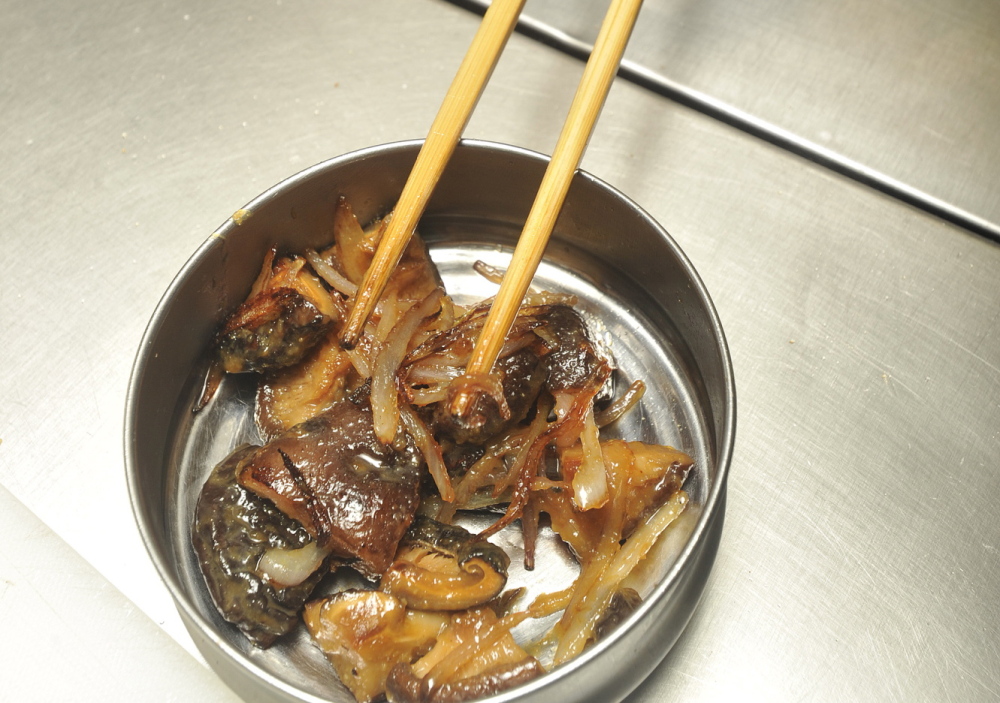At Tao Yuan restaurant in Brunswick, chef Cara Stadler mixes Asian ingredients with French technique and a Spanish tradition of small plates. It adds up to a highly personal style that she’s sometimes at a loss to explain. “Nothing is entirely anything,” she said in a telephone interview. “It’s hard for me to put a description on it.” (Delicious, maybe? The editors of Food & Wine magazine recently picked Stadler as one of the 10 Best New Chefs in America.) Case in point: this Braised Endive with Butter-Basted Fluke calls for endive (Belgian), dashi, shiitake mushrooms, miso and mirin (Japanese), caramelized sugar with fish (a Vietnamese technique) and butter-basting (a French technique). But while she thinks globally, she buys ingredients as locally as she can. Though she used endive to demonstrate the dish, she suggested locally grown escarole as a good substitute.
Like many restaurant dishes, this one has many components. For that reason, you’ll want to chop and otherwise prep your ingredients before you begin cooking. Several steps require that you keep a close eye, so once you start cooking, don’t wander off. Braised Endive with Butter-Based Fluke is occasionally on the menu at Tao Yuan. Not right at the moment, though – all the more reason to make it yourself.
Braised Endive with Butter-Basted Fluke
Serves 4 to 6
Stadler uses dashi for this dish, a Japanese fish stock made from shaved fish flakes (katsuobushi) and kombu seaweed. To make the recipe easier for home cooks, she suggests substituting fish or chicken stock. How did she think up fried quinoa as a garnish? “This dish has a lot of soft-on-soft textures,” Stadler explains. “Quinoa adds crunch to it.”
About 3 tablespoons vegetable or canola oil, divided use
4 heads of Belgian endive, quartered lengthwise
2 tablespoons sugar
2 cups fish or chicken stock (or dashi)
Salt to taste
4 tablespoons butter, divided use
1/4 cup quinoa
12 dried shiitake mushrooms
1 tablespoon mirin
1 tablespoon white miso
1 shallot, thinly sliced
1 1/2 to 2 pounds fluke fillets
Heat the oven to 350 degrees Fahrenheit.
Add just enough oil to a skillet to lightly coat it and heat over high heat (“This one is fast and furious,” says Stadler). Once the oil is hot enough to sizzle, add the endive. It’s important to keep it to a single layer, as you want it to caramelize, not steam. Turn the endive to brown on all sides. (Stadler uses large chopsticks for turning.) When the pieces are nicely browned, arrange them in a ceramic dish. Set aside.
Put the sugar in the now-empty skillet that you used to brown the endive. Add enough water to make a mixture with the texture of wet sand. Turn the heat to high. Do not walk away, and do watch the pan very carefully. The sugar will melt/liquify, then in a few minutes turn the color of caramel. Immediately, pour the stock into the pan – it will bubble up vigorously and is very hot, so take care. Pour this mixture over the reserved endive. Season with salt, scatter with 2 tablespoons of butter, in pieces, and cover the baking pan with foil. Bake 45 minutes to an hour until the core of the endive is very soft.
Meanwhile, bring a medium-size pot of water to boil, and boil the quinoa until it’s just slightly overcooked. How will you know? Each grain will be puffy and outlined with a white ring. If the grains are undercooked, when you fry them “they’ll become hard instead of crunchy and delicious,” Stadler says. Strain the quinoa in a fine-mesh sieve, then spread the quinoa out on a sheet tray to air dry for about 10 minutes. Heat 2 tablespoons oil in a small pot over medium heat. Set a strainer at the ready. Once the oil is hot and the quinoa slightly less wet, shallow-fry the grains until crispy, about 3 to 5 minutes. Immediately remove the quinoa from the heat (to keep the grains from burning) and pour through the strainer. Season the grains lightly with salt. Set aside.
Soak the dried shiitake mushrooms in hot water to cover and let soften for at least 15 minutes. Drain. Slice off and discard the stems and cut the caps into slices about 1/3-inch thick. Whisk the mirin and miso together and set aside. Add just enough oil to a skillet to coat and heat it over high heat. Add the shallots and rehydrated mushrooms and cook quickly to brown. Season lightly with salt. Once the vegetables are nicely browned, about 3 to 5 minutes, deglaze the pan with the reserved miso-mirin mixture (a chef’s way to say pour in the mixture and stir, incorporating any brown bits stuck to the bottom of the pan) and immediately remove the pan from the heat. The mixture will look browned and glossy.
Cut the fluke fillets into pieces you can easily flip with a spatula, about four- to 5-inch fillets. Pat dry and season with salt. Add just enough oil to a skillet to coat and heat. Sear the fish. Once the fillets are nicely browned on one side, flip and add the remaining 2 tablespoons butter. Lightly baste the fish with the butter, and place the pan in the oven for 4 to 6 minutes, depending on the size of the fillets; if the fillets are very thin, you can skip the oven and simply baste the fish on the stovetop until cooked. Once the fish is cooked, place it top of braised endive, top with the miso-mirin mushrooms and sprinkle with the toasted quinoa.
Send questions/comments to the editors.






Success. Please wait for the page to reload. If the page does not reload within 5 seconds, please refresh the page.
Enter your email and password to access comments.
Hi, to comment on stories you must . This profile is in addition to your subscription and website login.
Already have a commenting profile? .
Invalid username/password.
Please check your email to confirm and complete your registration.
Only subscribers are eligible to post comments. Please subscribe or login first for digital access. Here’s why.
Use the form below to reset your password. When you've submitted your account email, we will send an email with a reset code.